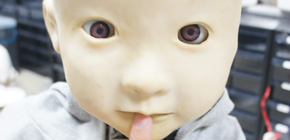
Basic skeleton of Affetto, a child-like android capable of smooth, realistic movement, developed
The next step toward a realistic baby android
A research team led by Assistant Professor Hisashi ISHIHARA and Professor Minoru ASADA designed and developed the skeleton for a small, child-like android that is capable of smooth movement with the aim of attaining intimate, child-like interaction. In order to realize smooth, flexible movement, a pneumatic drive system was adopted, which was designed to efficiently transfer any energy from the outside into the air inside. Additionally, through appropriate use of linear actuators, which move in a straight line, and rotary actuators, which create circular motion, corresponding to different parts of the body, the team was able to equip the robot with multiple movement mechanisms despite its small body size. Through the development of multiple test models, the team was able to improve the reliability and smoothness of the skeletal mechanism.
Due to these characteristics, this robot is able to express various feelings and move smoothly when interacting with people as well. In addition, through implementation of functional, flexible human-like skin, the child-like android Affetto was realized, capable of intimate interaction as if one was speaking with a child.
Abstract
Child robots have been used in a lot of studies on human–robot social/physical interaction because they are suitable for safe and casual experiments. However, providing many compliant joints and lifelike exteriors to enhance their interaction potential is difficult because of the limited space available inside their bodies. In this paper, we propose an upper body structure that consists of slider crank and parallel mechanisms for linear actuators and serial mechanisms for rotary actuators.
Such combinations of several joint mechanisms efficiently utilize the body space; in total, 22 degrees of freedoms were realized in an upper body space equivalent to that of an 80cm tall child. A pneumatic drive system was adopted in order to fully verify the behavioral performance of the body mechanism. The proposed redundant and compact upper body mechanism can be a platform for testing the effectiveness of future exteriors for the little child android ‘Affetto’, which was developed in order to integrate several key characteristics for achieving advanced human–robot interaction.
We developed a pneumatically-actuated 5 dof small humanoid leg with wide range of motion (ROM). Owing to their high mechanical durability and compliant motion, both linear and rotary vane cylinders were applied. Three rotational hip joints with orthogonal axes were realized with a vane cylinder and two linear cylinders, whose linear motion was converted to rotation by a reciprocating or an oscillating slider crank mechanism. The knee joint axis was realized by combination of a reciprocating slider crank mechanism and a crossed four-bar linkage mechanism for a linear cylinder. Link parameters for them were determined so that required sizes, torques, ROMs are satisfied and radial loads on cylinder heads, which prevent smooth and compliant cylinder motion, were minimized. We measured necessary external torques to drive pneumatic cylinders and confirmed that high backdrivability was maintained within each ROM.

Fig. 1 - Appearance of Affetto with a silicone skin on its head

Fig. 2 - Developed joint structure

Fig. 3 - Examples of possible postures of the developed legs

Fig. 4 - Appearance of the developed upper body joint structure that reduces physical shocks by changing its posture coordinately
To learn more about this research, please view the full research report entitled "Design of 22-DOF pneumatically actuated upper body for child android 'Affetto'" at this page of the Advanced Robotics website.
Related links
Content of research (from the homepage of Hisashi Ishihara, Ph.D.) (link in Japanese)
Content of laboratory research (from the homepage of Asada Laboratory)
